Versatile Elantras even challenge Sonata
By John Gilbert
LA JOLLA, CALIF.
Hyundai has never gotten the acclaim it deserves for shattering convention in the placid realm of midsize autos, forcing all competitors to revise their concepts as well as their cars and powertrains. It was in 2010 that Hyundai brought out the 2011 Sonata, as its conveyance to elite status in the auto world
It had dramatic new styling, with contours covering both sides and a sleek shape overall; a new 2.4-liter engine with an expensive and efficient direct-injection system that could attain 40 miles per gallon at freeway speeds; a body that, while shapely, was amazingly strong because of the predominance of high-strength steel; new house-built 6-speed stick and automatic transmissions; and all in a less-expensive package than more dominant midsize Accord, Camry, Mazda6, Altima, Malibu and Fusion.
That car thrust Hyundai into a previously unattained status in the car business, and forced competitors to shake out of their complacent lethargy and realize there were better ways to build cars and engines. Several updates and revisions have followed, raising the segment dwellers substantially for their 2017 models, with more to come in 2018.
While all of the midsize competitors have improved greatly in recent years, the smaller compact cars also have grown up and now boast remarkable improvements
At Hyundai, that means the last compact Elantra that came out, in 2015, has moved up in station to challenge the larger midsize stalwarts.
With that, we drop in out of the friendly skies to visit Torrey Pines Resort in La Jolla, California, .a suburb of San Diego that also includes a world-class golf course, along the Pacific coastline. It is a wonderful resort, and it is not far down the Coast from Hyundai’s U.S. base offices. That made it convenient as the site for waves of automotive media to experience the first drives of both the 201 Sonata, and the 2018 Elantra Sport and GT.
Hyundai gave the Sonata the leadoff slot as the flagship of the company’s identity in the U.S. market, and we had to wait until the next day to examine and drive the Elantra Sport and GT. That was intriguing, because the Sonata, looking more luxurious than ever and with refined driving capabilities, is really a well-crafted mid-cycle update, with stylish new front and rear designs, while the Elantra Sport and GT are entirely new.
We can introduce both of them together, but add the caution that you may be lured into the Hyundai dealership by the roomy and stylish Sonata, but do not overlook the equally flashy and conveniently sized Elantra, Elantra Sport, and Elantra GT.
My preference always has favored midsize cars, but as midsize cars grow in size to now approach full-size vehicles in roominess and luxury, the compacts have slyly grown too, and now are pretty much the size you may prefer in your quest for a midsize car.
The Elantra came out early in this calendar year, and the Elantra Eco, with a new-generation 1.4-liter turbocharged engine, followed in April. The Elantra GT comes next, available about November, and it will be the prize of the litter for folks who appreciate sporty driving and vehicles that respond well to sporty input. At a base price of $21,650, the Elantra Sport is a strong value for bargain shoppers still craving some fun in their driving
Any question of the Elantra GT’s credentials are eliminated by realizing it began life as the i30 in Europe, a sporty hatchback that likes to take on the Golf GTI and the hottest Ford Focus ST — with a sizzling turbo 2.0 that produces either 247 or 271 horsepower, both with 260 foot-pounds of torque. The best way to get the Elantra GT is the GT Sport package, which takes a large step up from the everyday Elantra GT. The U.S. version of the Elantra GT has the 2.0 engine without the turbocharger and with 162 horsepower at 6,200 RPMs, and 150 foot-pounds of torque at 4,700. It comes with either a 6-speed stick or 6-speed automatic.
The GT Sport parlays the 1.6-liter turbo 4 — my favorite — with a standard 6-speed stick or a 7-speed dual-clutch transmission and paddles. That package has 201 horses at 6,000 revs, and 195 foot-pounds of torque from 1,500-4,500 RPMs. The GT Sport also has multilink rear suspension and 18-inch wheels, compared to the torsion beam rear suspension and 17s in the Elantra GT.
Strangely, there are some items available on the GT Sport that are unavailable on the Elantra GT, such as blind-spot detection with rear cross-traffic, lane change assist, lane keep assist, smart cruise control, automatic emergency braking with pedestrian detection, and high beam assistance. Both vehicles have stability control, traction control, hill-start assist brake assist and rearview camera.
More curiously, while the Sonata has discontinued the very impressive panoramic sunroof for 2018, but the Elantra GT and Sport will offer it. The Sport has more bolstered bucket seats up front. The cars are built using 53 percent high-strength steel, leading to an 18 percent increase in the GT’s torsional rigidity, and the GT Sport is 22 percent more rigid and 61 pounds lighter than the previous model, with under-car cladding to improve aerodynamics to a 0.30 cd.
Driving on a hot day in the California mountains, we appreciated finding ventilated front buckets with cool air coursing through the seats. And the Infinity audio system has seven speakers and a subwoofer with plenty of power.
Along with all the contemporary connectivity devices and outlets, the remote start can be programmed into your smartphone, which can also turn on your rear defroster on cold mornings. The smart cruise has full stop-start, and there’s a driver attention assist as well.
We drove pretty hard and appreciated the precise feedback and curve-tracking capability of the Elantra GT and Sport GT, which put its quick-revving 1.6 turbo to good use. Hyundai estimates its previous 40-percent stick shift sales might be reduced to 20-40 percent, but that’s still high these days. The company also projects 15 percent of Elantra buyers will take the turbo, leaving 85 percent the rest of the line.
Statistically, the Elantra GT and Sport will have to take on a crowded compact field. The Elantra GT’s 55.1 cubic feet of interior storage will handle that well, compared to the Civic’s 46.2, Chevrolet Cruze 47.2, Mazda3 47.1, Focus 43.9 and Golf 52.7. One other interesting stat: We drove hard over the mountain roads and registered a surprising 41 miles per gallon
The Elantra is competitive enough that it might also challenge the larger and more profitable Sonata in overall room, as well as handling and performance. The lighter Elantra is 170.9 inches long compared to the Sonata 191.1; Elantra wheelbase is 104.3 inches to 110.4; width 70.7 to 73.4; and height 57.7 to the Sonata’s 58.1. That sounds like a big difference, but the Elantra Sport front and rear headroom is close to Sonata’s: legroom is 3 inches less front and 0.8 inches less in the rear, while shoulder room is also close, 56.2 inches front and 55.4 rear to the Sonata’s 57.9 front and 56.5 rear. The overall interior space is 121.4 in the Elantra to 122.4 in the Sonata.
Comparing designs of the 2018 Sonata and Elantra Sport makes it evident that the Sonata is intending to move upscale, and at that, it has the style, technology and roomy comfort to carry it off. The Elantra Sport, meanwhile, becomes a viable choice for a few thousand less, almost the same roominess, and the adventuresome look of the hatchback.
The larger midsize cars seem the most squeezed by the current rush to SUVs. New models of Accord and Camry have tried to catch the superb Mazda6 and jacked up the segment, and now into the midst of it all comes the seventh-generation Sonata, as a 2018 model.
When the 2011 Sonata breakthrough hit, it was very popular but drew criticism from skeptics who thought the curvaceous bodywork would be too trendy and might look old before its time. That was an erroneous theory, because while Hyundai scrambled to go back to more conservative designs in every revision, and it now looks quite generic — next to the still-distinctive 2011 Sonatas, which stand out as exclusive and readily recognizable.
For the 2018 refreshing, Hyundai hired Edward Lee, a young designer who had been working at Lexus. He said his task was a mission statement, “to create an instant ‘Wow!‘ factor.” Lee added that, “We aimed for a striking design starting with the side, where the shape starts low, from the tension of the nose.
“The front and rear have a new, upright athletic appearance. My favorite views are the front corner, where the contour lines come across the hood and angle down to the outer edges of our cascade grille, and a high view of the rear corner, which is much cleaner and emphasizes the car’s width and have a fresh, modern look, in what might be called horizontal elements in vertical arrangement. I like the way the lines, which connect the headlights and sweep back, all meet at the taillights.”
Lee confided that he, too, liked the look of the 2011 Sonata, and while he stopped short of saying he was attempting to reverse the trend, he acknowledged his first assignment for Hyundai was to make the Sonata more exciting.
John Shon, the senior product planning manager, talked about the signature cascade grille, which consists of horizontal bars aligned just right to amplify the hexagonal grille opening. With the broad horizontal top edge, then a short upper side bar, tapering down along longer lower side moldings to the bottom bar, the cascade term refers to the way molten steel flows out and downward. That, too, has meaning, because Hyundai is the only auto-maker that owns its own steel plant, which is why its cars are loaded with the costliest — and safest — high-strength steel.
My partner and I drove a Sonata Limited with the 2.4-liter 4-cylinder, and it handled the terrain and the curves of the mountain roads just east of La Jolla very well. After lunch in the mountain-area town of Julian, we switched to the Sport, with the 2.0-liter turbocharged engine. And proved conclusively that the quicker-revving engine, wider wheels and Michelin tires made a big improvement in handling and performance.
The range of Sonatas consists of the base SE 2.4 ($22,050 base price); the Eco 1.6-turbo ($22,650); the SEL 2.4 ($23,700); the SEL Tech 2.4 ($24,700); the Sport 2.4 ($25,200); the Limited 2.4 ($27,400); the Limited Ultimate 2.4 ($30,300); the Sport 2.0t ($27,600); and the Limited Sport 2.0t ($32,450).
The 2.4 is naturally aspirated with direct injection — the engine that put Hyundai on the international map as the joint venture still used by Fiat-Chrysler and Mitsubishi — and delivers a solid 185 horsepower at 6,000 RPMs and 178 foot-pounds of torque at 4,000 RPMs. The 2.0-turbo has 245 horsepower at 6,000 RPMs, and 260 foot-pounds at a steady flow from 1,350 to 4,000 RPMs. And the 1.6-liter turbo has 178 horsepower at 5,500 RPMs, and 195 foot-pounds from 1,500-4,500 RPMs.
The 2.4 comes with a 6-speed automatic, built by Hyundai, and the 2.0 turbo comes with the company’s upgraded 8-speed automatic, and both have Shiftronic to allow manual overrides. The 1.6-turbo has a higher-tech 7-speed dual-clutch automatic in the Eco, which will be out later this year. Hybrid and plug-in hybrid models will come out next year.
I liked the Sonata 2.0-Sport because it had paddles on the 8-speed automatic, and coming down from the mountains the paddles allowed me to drop down to fifth, fourth, or even third, and negotiate switchbacks without excessive braking. There was some excessive braking at one point, when a line of about 20 cars was stopped for a lengthy delay because of a rockslide that had come down from the bluff to our left and covered the two-lane highway. We didn’t mind pausing to let them clear that mess.
The Sonatas are built mostly at Hyundai’s Montgomery, Ala., plant, and at first, we assumed that was the more newsworthy. But the smaller Elantra was bigger news one day later, and unless I miss my guess, it will captivate you the same way in the showroom.


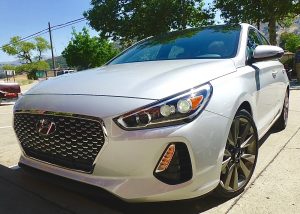
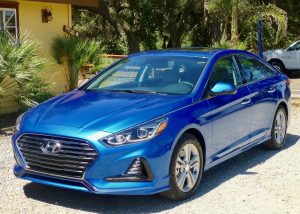
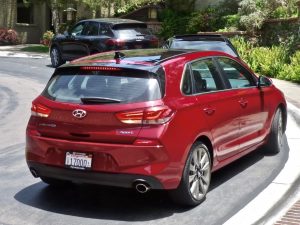
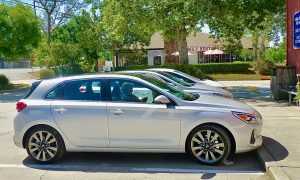
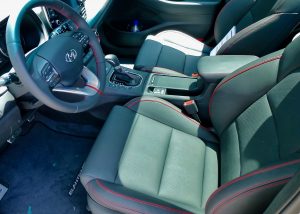
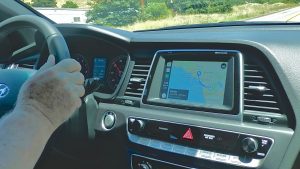
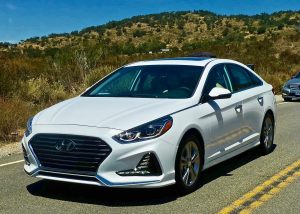
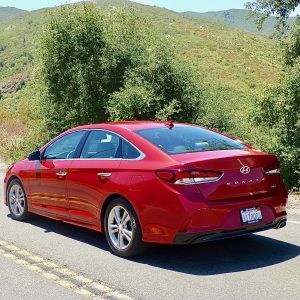
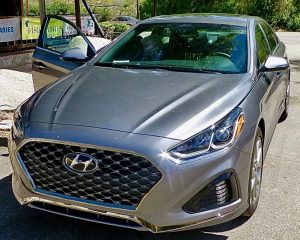
 John Gilbert is a lifetime Minnesotan and career journalist, specializing in cars and sports during and since spending 30 years at the Minneapolis Tribune, now the Star Tribune. More recently, he has continued translating the high-tech world of autos and sharing his passionate insights as a freelance writer/photographer/broadcaster. A member of the prestigious North American Car and Truck of the Year jury since 1993. John can be heard Monday-Friday from 9-11am on 610 KDAL(www.kdal610.com) on the "John Gilbert Show," and writes a column in the Duluth Reader.
John Gilbert is a lifetime Minnesotan and career journalist, specializing in cars and sports during and since spending 30 years at the Minneapolis Tribune, now the Star Tribune. More recently, he has continued translating the high-tech world of autos and sharing his passionate insights as a freelance writer/photographer/broadcaster. A member of the prestigious North American Car and Truck of the Year jury since 1993. John can be heard Monday-Friday from 9-11am on 610 KDAL(www.kdal610.com) on the "John Gilbert Show," and writes a column in the Duluth Reader.